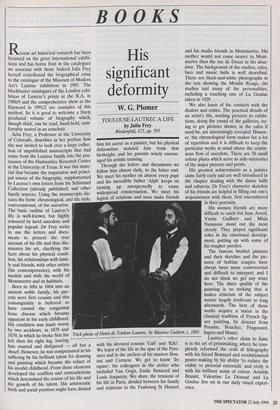BOOKS
His significant deform
W. G. Plomer
TOULOUSE-LAUTREC A LIFE by Julia Frey
Weidenfek4 £25, pp. 595
Recent art historical research has been focussed on the great international exhibi- tions and has borne fruit in the catalogues we associate with them. Indeed Julia Frey herself contributed the biographical essay to the catalogue of the Museum of Modern Art's Lautrec exhibition in 1985. The blockbuster catalogues of the London exhi- bition of Lautrec's prints at the R.A. in 1988/9 and the comprehensive show at the Hayward in 1991/2 are examples of this method. So it is good to welcome a finely produced volume of biography which, though thick, can be read, hand-held, com- fortably seated in an armchair. him his career as a painter, but his physical deformities isolated him from that birthright, and his parents wisely encour- aged his artistic training. Through the letters and documents we follow him almost daily, to the bitter end. We meet his mother on almost every page and his incredible father 'Alph' keeps on turning up unexpectedly to cause widespread consternation. We meet his legion of relations and soon make friends Trick photo of Henri de Toulose-Lautrec, by Maurice Guibert, c. 1891
with his devoted cousins 'Gab' and 'Kik?. We learn of the life in the spas of the Pyre- nees and in the ateliers of his masters Bon- nat and Cormon. We get to know les rapins', his colleagues in the atelier who included Van Gogh, Emile Bonnard and Louis Anquetin. We share the tensions of his life in Paris, divided between his family and relations in the Faubourg St Honore and his studio friends in Montmartre. His mother would not come nearer to Mont- martre than the rue de Douai in the deux- ihme. The background of the studios, cafes, bars and music halls is well described. There are black-and-white photographs in the text showing the Moulin Rouge, the studios and many of the personalities, including a touching one of La Goulue taken in 1929.
We also learn of his contacts with the dealers and critics. The practical details of an artist's life, sending pictures to exhibi- tions, doing the round of the galleries, try- ing to get pictures shown, in the cafes if need be, are interestingly revealed. Howev- er, the chronological form makes for a lot of repetition and it is difficult to keep the particular works in mind above the contin- uous flow of anecdote. There are 50 small colour plates which serve as aide-memoires of the major pictures and prints.
His greatest achievements as a painter came fairly early and are well introduced in the chapter dealing with the dance halls and cabarets. Dr Frey's character sketches of his friends are helpful in filling out one's acquaintance with them, first encountered in their portraits.
His women friends are more difficult to catch but Jane Avert!, Yvette Guilbert and Misia Natanson stand out the most clearly. They played significant roles in his emotional develop- ment, putting up with some of his rougher patches.
The famous brothel pictures and their sketches and the pic- tures of lesbian couples have always been more controversial and difficult to interpret, and I do not think we get any wiser here. The sheer quality of the painting is so striking that it makes criticism of the subject matter largely irrelevant so long afterwards. The best of these works acquire a status in the classical tradition of French fig- ure painting, by descent from Poussin, Boucher, Fragonard, Ingres and Manet.
Lautrec's other claim to fame is in the art of printmaking, where he com- pletely reformed the craft of lithography with his friend Bonnard and revolutionised poster-making by his ability `to reduce the visible to pictorial essentials' and vivify it with his brilliant sense of colour. Aristide Bruant, Valentine Le Desosse and La Goulue live on in our daily visual experi- ence. Lautrec's working career spanned the glittering decade of Paris' belle epoque' from the first centenary of the Revolution to the Exposition Universe& in 1900, and he was very much a man of his time. The last chapter of Dr Frey's book is sad reading, chronicling his decline in the touching let- ters to his mother from Berthe Sarrazin, her housekeeper, and from the male friends who were left to watch over him. However, in the last few months before his death in 1901 he painted two of his most remarkable pictures — the milliner, 'Mlle. Blouet', and the 'Faculty of Medecine'. Imagine what he would have achieved had he lived as long as Bonnard, who died in 1947.
W. G. Plomer was Print Specialist at Agnew's



















































 Previous page
Previous page